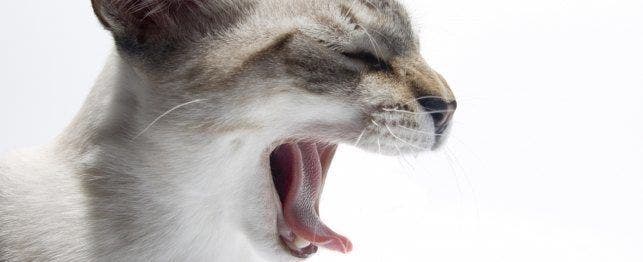
Why Do Cats Yawn?
Someone once said that a yawn is a cat’s honest opinion openly expressed. Have you ever watched a cat yawn? His mouth opens so wide, you can count every tooth. It has been estimated that a cat yawns on the average of 109,500 times in his life.
Lots of animals yawn. Humans yawn; the earliest yawn often occurs 11 weeks after conception – that’s before the baby is born. The yawn becomes contagious somewhere in the first five years of life. Chimpanzees and apes yawn, and they yawn infectiously just like us. Fish and birds also yawn.
We don’t really know why cats yawn. In fact we don’t really know why we yawn, although there are several theories.
- The physiological theory. This theory claims that you yawn because of low oxygen levels in the blood. Yawning causes you to take a deep breath, stimulating respiratory gas exchange and also the heart and blood flow.
- The arousal theory. The concept here is that the cat is torn between two drives. He may be tired and want to sleep but is forcing himself not to nap, for some reason. Stress may make cats yawn as they struggle to stay awake when they are concerned about something.
- The boredom theory. If you find something boring, you will yawn.
- The evolutionary theory. We yawn to display our teeth, a behavior left over from our primitive beginnings.
- Communication theory. Just like smiling tells people you are happy, yawning simply lets people know you are tired (or bored).
- A release of energy. The ritualized motion involves coordinated muscle movement that burns off extra energy to help ease you into relaxation.
The Protective Yawn
Cats often yawn and stretch when they wake up in the morning, but they rarely yawn in the evening when they are tired. Cats also yawn in times of conflict. For example, if there is a dish of food nearby but the dog is standing over the dish, your cat may have conflicting urges: One urge to eat and the other to protect himself. In this case he might yawn as a displacement behavior.
Consider the situation in an evolutionary context: Putting on a “sleepy” display by yawning, allows the animal to escape a problematic situation gracefully, without sending out the message that he is scared, confused, or in conflict with others. It’s much like our method of “whistling in the graveyard.” Interestingly, if you yawn at a cat, it tells him you mean him no harm.
One More Theory
Just as “a kiss is still a kiss, a sigh is just a sigh,” a yawn may be … well, just a yawn. Cats usually stretch those muscles in their backs when they yawn; in fact, their whole body is involved – the spine, the neck, the jaw. This has got to feel good.
(How many times did you yawn while reading this article?)